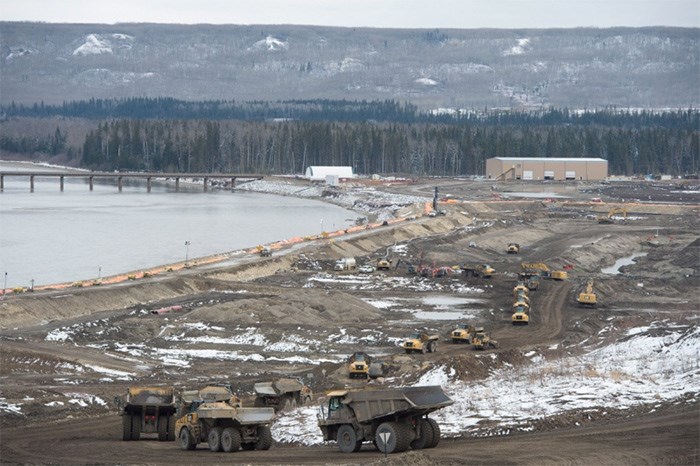 Site C dam along the Peace River near Fort St. John. April 2017 Photograph By JONATHAN HAYWARD, The Canadian Press
Site C dam along the Peace River near Fort St. John. April 2017 Photograph By JONATHAN HAYWARD, The Canadian Press
Cancelling or suspending the $9-billion Site C dam on the Peace River shifted from options to distinct possibilities this week, as B.C. Hydro retreated from a crucial point it has been sticking to for months.
The new CEO formally conceded that the project will be over budget, because he can’t make next year’s deadline to divert the river for a critical phase of the dam construction.
Chris O’Riley, who has been in charge of the work since it started and became CEO after the change of government ousted the former B.C. Liberal appointee, said that will tack $610 million on to the costs, and pushes the project past its contingency funding.
It also heightens skepticism about other schedules, price quotes and assurances that taxpayers have been given going back years about the project. Those doubts are in play at the same time the independent utilities commission, which indirectly forced the confession, is poring over the whole project.
This isn’t quite the Titanic hitting the iceberg. It’s more that something repeatedly acknowledged as a risk has become a certainty, just at a time when all the other risks are being scrutinized. It’s enough to prompt a cold sweat in the senior ranks of B.C. Hydro officials as they await the cabinet verdict on the dam’s future. It’s also enough to instil a sense of dread within everyone who is going to pay more regardless of what happens to the project.
The setback was declared early enough in the seven-year schedule that the completion date could still be met, says Hydro.
But it’s also early enough to make the NDP cabinet wonder: What else can go wrong? The project has slipped seven per cent over budget just two years and $2 billion into the work, mostly because of two cracks in the graded river bank that needed fixing.
B.C. Hydro also acknowledged in filings with the utilities commission that it is in dispute with the contractors over the causes of the delays and who should pay for what. Those differences are routine in most construction jobs, but these ones are bigger.
There are also significant risks ahead in the second-biggest part of the project, buying and installing the actual generating equipment, as well as a highway realignment.
Despite all that, Hydro told the utilities commission it’s keen to push ahead. Mostly because executives think it’s too late to turn back.
The latest filing says if the dam is terminated, ratepayers would incur $3.2 billion in costs “without anything to show for it.”
Hydro also said that Site C could run 50 per cent or more over budget and still be more cost-effective than the alternative sources that others are touting. That’s either reassuring or terrifying, depending on your outlook.
The statement relates to an ongoing argument about the cost assumptions related to alternative sources of power. The commission will have to resolve that en route to delivering its report to cabinet by Nov. 2.
That report won’t make a recommendation. It will just be hard data on three options — complete the dam on schedule in 2024, suspend it indefinitely or terminate the project. One of the basic questions it has to answer along the way is whether the project is on budget.
The preliminary report last month found that it was. Now the final report will conclude it is not. How much weight the commission puts on that while reporting on the three options will shape the framework for cabinet’s eventual decision.
The political arguments over that call will run forever. The costs will run almost as long. Governments can recover from all kinds of mistakes. But the ones that have the biggest ramifications usually relate to power.
On a broader scale, B.C.’s reputation is on the line to some extent.
At a time when 21st-century engineering marvels abound, after almost 40 years of off-and-on study, the biggest Crown corporation in B.C. faces tough questions about whether it can finish what it has always described as a relatively low-impact addition to the power system.


